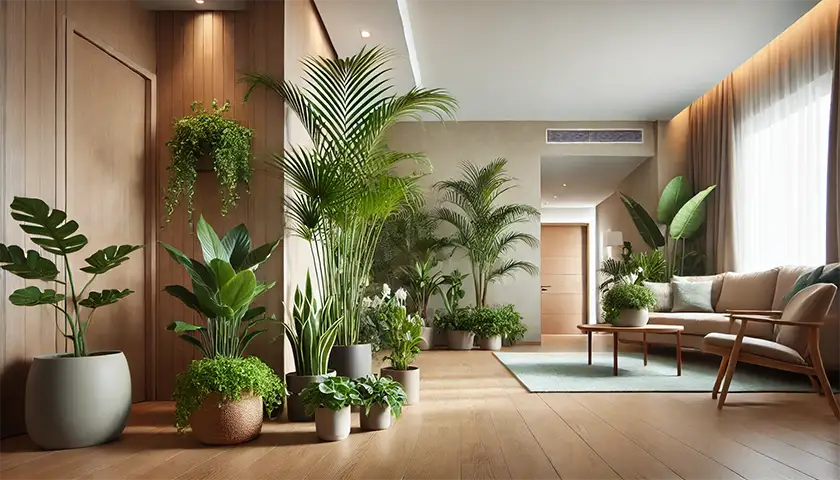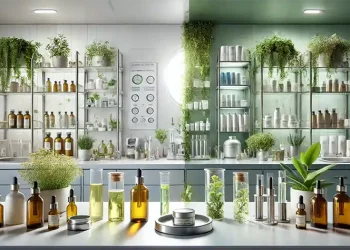Air-Purifying Plants : In today’s fast-paced world, we often overlook the quality of air in our homes. While we focus on outdoor pollution, the air we breathe indoors can be up to five times more polluted. From harmful toxins to dust and allergens, indoor bad air quality can negatively affect our health and well-being.
The good news? Nature has a solution! By incorporating air-purifying plants into your home, you can enhance indoor air quality naturally. These plants don’t just add aesthetic value but also work as natural air filters. Let’s dive into the top 10 air purifying plants that can make your home healthier and fresher.
What are Air-Purifying Plants?
Air-purifying plants are natural filters that help clean the air inside your home. They absorb pollutants like carbon monoxide, formaldehyde, and benzene while releasing fresh oxygen. Incorporating these plants into your indoor space not only enhances air quality but also contributes to mental well-being and productivity.
Air Purify vs. Air-Purifying Plants: Which is Better?
When it comes to improving indoor air quality, both air purifiers and air-purifying plants play an essential role. Here is a comparison to help you understand their effectiveness:
| Aspect | Air Purify (Using Air Purifiers) | Air-Purifying Plants |
|---|---|---|
| Mechanism | Uses technology to clean the air. | Uses natural processes to filter air. |
| Effectiveness | Immediate and precise. | Gradual improvement over time. |
| Cost | Expensive (initial and maintenance). | Cost-effective and long-lasting. |
| Additional Benefits | No aesthetic value. | Adds beauty and reduces stress. |
| Environmental Impact | High energy consumption. | Eco-friendly and sustainable. |
Both methods complement each other. While air purifiers are highly effective for immediate air purification, air-purifying plants offer long-term benefits, aesthetic appeal, and an eco-friendly approach. For the best results, a combination of both can be used to ensure optimal indoor air quality.
Top Air-Purifying Plants for Your Home
1. Spider Plant (Chlorophytum comosum) – Best Air-Purifying Plant
Spider plants are hardy, low-maintenance, and highly effective at removing carbon monoxide, formaldehyde, and other pollutants from the air.
- Benefits: Pet-friendly and ideal for beginners.
- Care Tips: Thrives in indirect sunlight and requires minimal watering.
2. Snake Plant (Sansevieria trifasciata)
Also called “Mother-in-Law’s Tongue,” the Snake Plant is one of the best air-purifying plants for bedrooms. It releases oxygen at night, making it ideal for improving sleep quality.
- Benefits: Removes toxins like benzene, formaldehyde, and xylene.
- Care Tips: Tolerates low light and requires infrequent watering.
3. Areca Palm (Dypsis lutescens)
Areca Palm, also known as the butterfly palm, is a popular choice for improving air quality. This lush green plant is not only beautiful but also effective in removing toxins like carbon dioxide and increasing indoor oxygen levels.
- Benefits: Excellent at increasing humidity, especially useful during dry winters.
- Care Tips: Prefers indirect sunlight and regular watering to keep the soil moist.
4. Peace Lily (Spathiphyllum)
The Peace Lily is known for its striking white blooms and ability to remove airborne toxins like ammonia and benzene.
- Benefits: Acts as a natural humidifier and improves air quality.
- Care Tips: Prefers shade and weekly watering.
5. Boston Fern (Nephrolepis exaltata)
Boston Ferns are lush, leafy plants that are excellent for increasing indoor humidity. They effectively remove pollutants like formaldehyde and xylene.
- Benefits: Ideal for dry environments or homes with air conditioning.
- Care Tips: Needs indirect sunlight and high humidity, so mist it regularly.
6. Aloe Vera
Aloe Vera isn’t just great for skincare; it’s also a fantastic air-purifying plant. It removes formaldehyde and benzene while adding a fresh look to your home.
- Benefits: Releases oxygen at night, making it perfect for bedrooms.
- Care Tips: Prefers bright, indirect sunlight and infrequent watering.
7. Rubber Plant (Ficus elastica)
The Rubber Plant is a powerful toxin remover, capable of eliminating pollutants like formaldehyde from indoor air.
- Benefits: Enhances air quality while being low-maintenance.
- Care Tips: Prefers moderate light and consistent watering.
8. Bamboo Palm (Chamaedorea seifrizii)
Bamboo Palms are great for removing airborne toxins and adding a tropical vibe to your home. They are particularly effective at filtering benzene and formaldehyde.
- Benefits: Increases humidity and reduces airborne toxins.
- Care Tips: Requires indirect sunlight and regular watering.
9. Dracaena (Dracaena spp.)
With its striking leaves, Dracaena is a versatile and effective air-purifying plant. It removes harmful substances like trichloroethylene and benzene.
- Benefits: Available in various varieties to suit different home aesthetics.
- Care Tips: Prefers bright, indirect sunlight and moderate watering.
10. Golden Pothos (Epipremnum aureum)
Golden Pothos, also known as “Devil’s Ivy,” is a robust plant that thrives in most indoor conditions. It’s excellent at removing indoor air toxins like carbon monoxide and formaldehyde.
- Benefits: Grows quickly and adapts to low light.
- Care Tips: Water when the soil feels dry and keep it in indirect light.
Also Read This : Air Quality Index (AQI) Explained: What It Means for Your Health
Additional Benefits of Air-Purifying Plants
Stress Reduction and Mental Well-Being
Studies suggest that incorporating greenery into your living space can significantly reduce stress and anxiety levels. Air-purifying plants not only clean the air but also promote a calming environment, making your home a sanctuary of peace.
Enhancing Sleep Quality
Plants like the Snake Plant and Aloe Vera release oxygen during the night, which can improve sleep quality. Adding these to your bedroom setup ensures you wake up refreshed and energized.
Cost-Effective Air Filtration
Unlike mechanical air purifiers, air-purifying plants offer a budget-friendly alternative to improving indoor air quality. They require minimal maintenance and have long-lasting benefits.
Boosting Productivity
Having plants in workspaces has been linked to increased focus and productivity. Whether it’s a small desk plant or a larger potted tree, the presence of greenery can enhance creativity and efficiency.
How Air-Purifying Plants Improve Your Life
Air-purifying plants don’t just purify the air they also boost your mood, productivity, and overall well-being. Studies have shown that greenery in indoor spaces reduces stress, increases focus, and creates a calming atmosphere. Incorporating these plants into your home is a simple and cost-effective way to improve your living environment.
Disclaimer
This article provides general information on air purifying plants and their benefits. It is not a substitute for professional advice or treatment. Always consult a specialist or your own research before introducing new plants, especially if you have allergies or pets. Well Health Organic does not take responsibility for the accuracy or completeness of this information.















